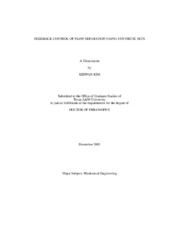| dc.description.abstract | The primary goal of this research is to assess the effect of synthetic jets on flow separation
and provide a feedback control strategy for flow separation using synthetic jets.
The feedback control synthesis is conducted based upon CFD simulation for a rounded
backward-facing step. The results of the synthetic jet experiments on an airfoil showed
that synthetic jets have the potential for controlling the degree of flow separation beyond
delaying the onset of flow separation. In the simulation, while the jet is ejected slightly
upstream from the separation point, the feedback pressure signal is acquired at a downstream
wall point where the vortex is fully developed. Due to the uniqueness of synthetic
jets, i.e. "zero-net-mass flux", the profile of synthetic jet velocity cannot be arbitrarily generated.
The possible control variables are the magnitude or frequency of the oscillating jet
velocity. Consequently, the fluidic system in simulation consists of the actuator model and
the NARMAX (Nonlinear Auto Regressive Moving Average with eXogenous inputs) flow
model. This system shows a strong nonlinear pressure response to the input jet frequency.
Low-pass filtering of the pressure response, introduced for pressure recovery, facilitates
a quasi-linear approximation of the system in the frequency domain using the describing
function method. The low-pass filter effectively separates the pressure response into two
frequency bands. The lower frequency band below the filter pass frequency includes the
quasi-linear response targeted by the feedback control and the higher band above the filter
stop frequency contains the attenuated higher harmonics, which are treated as nonlinear disturbances. This quasi-linear approximation is utilized to design a PI controller for the
fluidic system including the synthetic jet. To ensure one-to-one correspondence of the jet
frequency and the filtered pressure response, the upper bound of the jet frequency is set at
the frequency of the maximum pressure. The response of the resulting closed loop feedback
control system, comprised of a PI controller, low-pass filter, SJA model and NARMAX
model, is shown to track the desired pressure command with an improvement in the
transient response over the open-loop system. | en |


